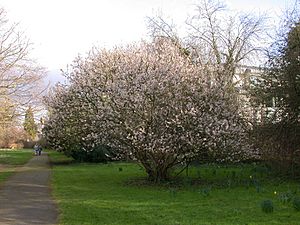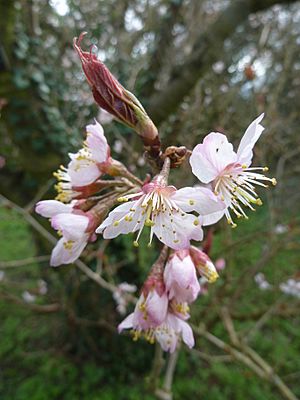Prunus pseudocerasus facts for kids
Quick facts for kids Prunus pseudocerasus |
|
|---|---|
 |
|
| Chinese sour cherry in bloom | |
| Scientific classification | |
| Genus: |
Prunus
|
| Species: |
pseudocerasus
|
| Synonyms | |
|
|
The Chinese sour cherry, also known as Prunus pseudocerasus, is a type of cherry tree. It comes from China and is now grown all over the world. People love it for its beautiful cherry blossoms that appear early in spring. Some types of this cherry tree also grow fruits that you can eat, even though they are a bit tart!
What Does the Chinese Sour Cherry Look Like?
This tree is usually small and bushy. It can grow up to about 8 meters (26 feet) tall. Its buds are often reddish, and its flowers are a pale pink, about 2 centimeters (0.8 inches) wide. The cherries are typically red and about 1.5 centimeters (0.6 inches) across.
You can tell this cherry tree apart from others by a few things. Its leaves are quite large, from 7 to 16 centimeters (2.8 to 6.3 inches) long. They are wider at the top and pointy at the end. The edges of the leaves are flat and have small, sharp teeth, like a saw. Its flowers grow in small clusters, usually with three to seven flowers together. The branches and flower stalks are covered in fine, soft hairs.
Why is the Chinese Sour Cherry Important?
For about 2,000 years, people in China have grown this cherry tree for its fruit. Even though the fruit is tart, it is edible. In Japan, this tree is very popular as an ornamental tree. It blooms even earlier than the famous Japanese cherry, Prunus serrulata.
The Chinese sour cherry is also special because it has more sets of chromosomes than many other plants. This makes it useful for growing other types of flowering cherries. It can be used as a "rootstock," which means its roots and lower stem are used to grow another cherry tree on top. This tree is also strong against a common plant sickness called cherry leaf spot, which is caused by a fungus.
The fruits of P. pseudocerasus are healthy too! They contain important things like carotene, vitamin C, proteins, sugars, iron, and phosphorus. Sadly, this cherry tree is almost gone in the wild because of human activities.


